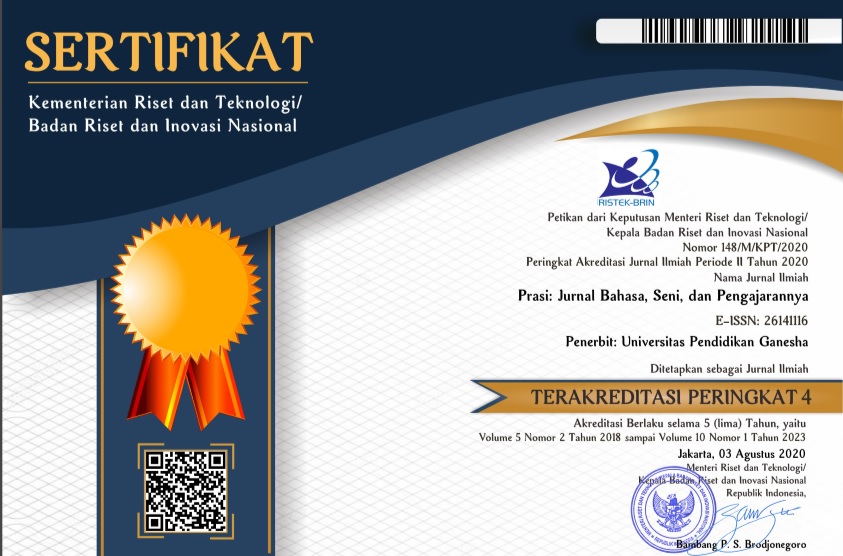MENINGKATKAN KEMAMPUAN BERBICARA BAHASA JEPANG MELALUI VIDEO PRESENTASI DESTINASI WISATA
DOI:
https://doi.org/10.23887/prasi.v19i01.67655Keywords:
Video presentasi;, kemampuan berbicara;, bahasa JepangAbstract
Speaking proficiency is a crucial aspect of language learning, particularly in foreign languages like Japanese. However, both teachers and learners face numerous challenges in enhancing this skill. This research aims to examine the use of video presentations in improving Japanese language learners' speaking abilities. The problems encountered include a lack of interest, difficulties in objectively assessing progress, and challenges in devising effective methods and materials. On the learners' side, challenges include low self-confidence, public speaking anxiety, limited vocabulary, and difficulties in expressing ideas clearly. The methodology employed in this study is a mix of quantitative and qualitative methods. Data were collected through feedback, teacher evaluations, and interviews with fourth-semester students of the Japanese Language D-3 Program at UNTAG Semarang.The research findings indicate that the use of video presentations is effective in enhancing students' speaking abilities. Students reported increased confidence and speaking skills after using video presentations. They also demonstrated improvements in organizing ideas, selecting appropriate vocabulary, and delivering information clearly and coherently. Students generally responded positively to the use of these presentation tasks. Evaluations also showed that video presentations provide relevant and beneficial contexts for developing Japanese language skills, including vocabulary expansion, pronunciation, and fluency. In conclusion, the use of video presentations in Japanese language learning is effective in improving students' speaking abilities. Recommendations can be made to further develop and refine this method in a broader learning context.
Keywords : Video presentation, video, speaking skills, Japanese.
Abstrak
Kemampuan berbicara adalah aspek penting dalam pembelajaran bahasa, terutama bahasa asing seperti bahasa Jepang. Namun, banyak tantangan yang dihadapi baik oleh pengajar maupun pembelajar dalam meningkatkan kemampuan berbicara ini. Penelitian ini bertujuan untuk mengkaji penggunaan video presentasi dalam meningkatkan kemampuan berbicara mahasiswa bahasa Jepang. Permasalahan yang dihadapi adalah kurangnya minat, kesulitan menilai kemajuan secara objektif, dan kesulitan menyusun metode dan materi yang efektif. Di sisi pembelajar, tantangan meliputi kurangnya percaya diri, kecemasan berbicara di depan umum, keterbatasan kosakata, dan kesulitan menyampaikan ide dengan jelas. Metode yang digunakan dalam penelitian ini adalah mix method, yaitu campuran antara kuantitatif dan kualitatif. Data dikumpulkan melalui umpan balik, evaluasi pengajar, dan wawancara terhadap mahasiswa semester empat Program Studi D-3 Bahasa Jepang di UNTAG Semarang. Hasil penelitian menunjukkan bahwa penggunaan video presentasi efektif dalam meningkatkan kemampuan berbicara mahasiswa. Mahasiswa melaporkan peningkatan percaya diri dan keterampilan berbicara setelah menggunakan video presentasi. Mereka juga menunjukkan peningkatan dalam mengorganisir ide, memilih kosakata yang tepat, dan menyampaikan informasi dengan jelas dan terstruktur. Respon mahasiswa terhadap penggunaan tugas presentasi ini secara umum positif. Evaluasi juga menunjukkan bahwa video presentasi memberikan konteks yang relevan dan bermanfaat dalam mengembangkan kemampuan bahasa Jepang, termasuk penambahan kosakata, pengucapan, dan kelancaran berbicara. Kesimpulannya, penggunaan video presentasi dalam pembelajaran bahasa Jepang efektif dalam meningkatkan kemampuan berbicara mahasiswa. Rekomendasi dapat diberikan untuk terus mengembangkan dan memperbaiki metode ini dalam konteks pembelajaran yang lebih luas.
References
Akhyak, D., Indramawan, A., & Pd, M. (2013). Improving the Students’ English Speaking Competence through Storytelling (Study in Pangeran Diponegoro Islamic College (STAI) of Nganjuk, East Java, Indonesia). International Journal of Language and Literature, 1(2).
Atmazaki, Ramadhan, S., Indriyani, V., & Nabila, J. (2021). Dialogic-Interactive Media Design for Language Learning To Improve Speaking Activities and Skills. Journal of Physics: Conference Series, 1779(1), 012029. https://doi.org/10.1088/1742-6596/1779/1/012029
Bashori, M., van Hout, R., Strik, H., & Cucchiarini, C. (2022). Web-based language learning and speaking anxiety. Computer Assisted Language Learning, 35(5–6), 1058–1089. https://doi.org/10.1080/09588221.2020.1770293
Brown, H. D. (2006). Language Assessment: Principles and Classroom Practices (Nachdr.). Longman.
Fauzi, I. (2016). The Application of Multimedia-Based Presentation in. Journal of ELT Research, 1(1).
Ginanjar, P. Y. (2020). Enhancing Students Motivation in Japanese Conversation (Online Course): Through CM. IZUMI, 9(1), 31–39. https://doi.org/10.14710/izumi.9.1.31-39.
Hammarberg, K., Kirkman, M., & de Lacey, S. (2016). Qualitative research methods: When to use them and how to judge them. Human Reproduction, 31(3), 498–501. https://doi.org/10.1093/humrep/dev334
Ihsan, M. D. (2020). The Application of Presentation Practice Production Method for Teaching Speaking Skill: The Perception of Teachers and Students. Jurnal Inspirasi Pendidikan, 10(1), 30–40. https://doi.org/10.21067/jip.v10i1.3854
Irawati, D. (2016). Supporting Student’s English Speaking Achievement Using Video. International Journal of EFL, 1(1), 45. https://doi.org/10.21462/ijefl.v1i1.5
Menggo, S., Basir, A., & Halum, Y. S. (2022). Video-Based Tasks in Strengthening Speaking Skills of EFL College Students. Indonesian Journal of EFL and Linguistics, 7(2), 279. https://doi.org/10.21462/ijefl.v7i2.510
Oya, T., Manalo, E., & Greenwood, J. (2009). The Influence of Language Contact and Vocabulary Knowledge on the Speaking Performance of Japanese Students of English. The Open Applied Linguistics Journal, 2(1), 11–21. https://doi.org/10.2174/1874913500902010011
Putri, R. N., & Rahmani, B. D. (2019). Students Perception on Using Video Recording to Improve Their Speaking Accuracy and Fluency.
Sirisrimangkorn, L. (2021). Improving EFL Undergraduate Learners’ Speaking Skills Through Project-Based Learning Using Presentation. Advances in Language and Literary Studies, 12(3), 65. https://doi.org/10.7575/aiac.alls.v.12n.3.p.65
Tran, N. H., Marinova, K., & Nghiem, V. H. (2023). Exploring Perceived Speaking Skills, Motives, and Communication Needs of Undergraduate Students Studying Japanese Language. Education Sciences, 13(6), 550. https://doi.org/10.3390/educsci13060550
Tuan, N. H., & Mai, T. N. (2015). Factors Affecting Students’ Speaking Performance At Le Thanh Hien High School. 3(2).
Wood, D. (2007). Mastering the English formula: Fluency development of Japanese learners in a study abroad context. JALT Journal, 29(2), 209. https://doi.org/10.37546/JALTJJ29.2-3
Downloads
Published
Issue
Section
License
Copyright (c) 2024 Sri Muryati, Bekti Setio Astuti

This work is licensed under a Creative Commons Attribution-ShareAlike 4.0 International License.
Authors who publish with Prasi agree to the following terms:- Authors retain copyright and grant the journal the right of first publication with the work simultaneously licensed under a Creative Commons Attribution License (CC BY-SA 4.0) that allows others to share the work with an acknowledgment of the work's authorship and initial publication in this journal
- Authors are able to enter into separate, additional contractual arrangements for the non-exclusive distribution of the journal's published version of the work (e.g., post it to an institutional repository or publish it in a book), with an acknowledgment of its initial publication in this journal.
- Authors are permitted and encouraged to post their work online (e.g., in institutional repositories or on their website) prior to and during the submission process, as it can lead to productive exchanges, as well as earlier and greater citation of published work. (See The Effect of Open Access)


.png)
.png)









